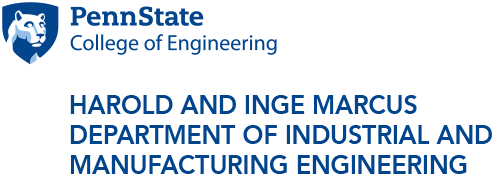
Assistant professor Scarlett Miller, center, and students Elizabeth Starkey and Clayton Meisel discuss how to illustrate the complexity of a physical product through a virtual user interface.
NSF supports research on product design, innovation and learning
9/25/2015
UNIVERSITY PARK, Pa. — Scarlett Miller, assistant professor of engineering design and industrial engineering, and Samuel Hunter, associate professor of industrial and organizational psychology, have been awarded a grant of $347,443 by the National Science Foundation (NSF) to research how the design of an existing product impacts a student’s ability to create innovative designs that meet the same societal needs.
Miller and Hunter are co-principal investigators on the three-year project, titled “Understanding the Impact of Product Dissection on Design Innovation and Learning.”
“Recent studies have suggested that first-year engineering students may actually be more creative than their senior-level counterparts, bringing into question how to support, rather than restrain, creative development in engineering education,” said Miller. “This research is an important step toward producing more forward-thinking engineers and also improving distance-learning programs and techniques by encouraging students to generate solutions using more non-traditional design tools.”
The goal of the project is to improve the innovation capacity of engineering students by understanding how deconstructing existing products either by hand or virtually impacts students' ability to design more innovative solutions to engineering challenges.
“Holding a product and physically being able to see how it is constructed is beneficial to many students during the learning process,” said Miller. “But from an innovation perspective, being able to touch the product and see it may be detrimental when students are asked to improve the design because they have this preconceived notion of what the product looks like and how it works.”
There is also the issue of cost and environmental sustainability to take into consideration as many products can only be disassembled one time before they are rendered useless. However, through virtual dissection, a product can be viewed as a computer-aided-design model multiple times at multiple angles and different parts can be added and taken away at no cost.
“With traditional hands-on dissection, team members often have to huddle around one or two dissected products,” explained Hunter. “Virtual tools, however, open the door for a range of possibilities to share and exchange ideas whether it be applied to distally located, virtual teams or simply allowing designers to work across differing platforms and tools. The social and psychological implications for designing in groups are significant.”
The basis of the research comes from Miller and Hunter’s combined expertise in creativity and design cognition, Miller’s familiarity with product design and human-computer interaction and Hunter’s knowledge of team innovation.
Miller and Hunter will be observing students enrolled in several engineering design courses at Penn State to gain a better understanding of the amount of mental effort (also called the “cognitive load”) required to perform the dissection activities, and then determine the effect cognitive load has on the knowledge a student retains about the product and the impact of this knowledge on student creativity.
“Through the results of this research we will be able to create more effective hands-on learning modules so we can more efficiently train engineers to be more innovative when creating engineering solutions,” said Miller.
One of the important takeaways from this project will be understanding the benefits and detriments of both hands-on and virtual training, which will impact the design of not only in-residence educational programs but also distance programs, massive open online courses (more commonly called MOOCs), and other distance-learning activities at multiple grade levels, so it is not exclusive to higher education.
“At the core of this research, we are seeking to understand how to improve the creative process as it shifts and changes in the more virtual and digital modern era,” added Hunter.
Miller received an NSF Career Award in May 2014 and will focus on the engineering design aspects of the research with the help of Clayton Meisel, an undergraduate in mechanical engineering, and Elizabeth Starkey, a doctoral student in industrial engineering.
Hunter has been issued three NSF grants over the past five years and will look at the development of creativity and innovation in designing a course. Alex McKay, a graduate student in psychology, will also be assisting in the research.



